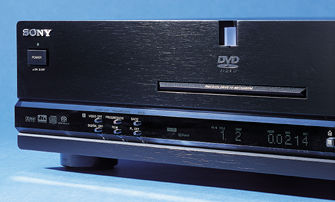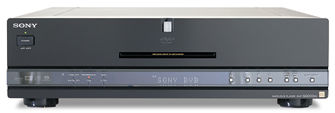Sony DVP-S9000ES SACD/DVD Player
Sign up for a Vons-supermarket club card today, and you can purchase a name-brand DVD player for $170! It's true. We saw it with our own eyes.

DVD sales are sky-rocketing, while the average DVD-player price has dropped through the floor. So, how does a company expect to sell a player that costs 25 percent more than their previous top-of-the-line model and about 900 percent more than the player mentioned above? Simple: add more cool stuff.
The DVP-S9000ES is Sony's most expensive DVD player to date, partly due to the addition of the progressive-scan outputs. By the same token, this is their least expensive Super Audio CD (SACD) player, offering high-resolution audio to a larger number of people. Keep in mind that progressive-scan players cost about a grand. Likewise, many SACD players still cost several thousand dollars.
To help dissect these two very different technologies, we (audio editor Chris Lewis and senior technical editor Mike Wood) divided the review in half. Mike handled the ergonomics and video performance, while Chris tested and explains the audio quality.
Sony has taken a clear departure from the design of their previous players. The DVP-S7700, for example, wasn't an artistic masterpiece, but it did have an attractive look for a DVD player. The DVP-S9000ES goes for a smoother, simpler appearance with a black aluminum faceplate and a slim, nonresonant, nonscratching drawer that slides out of the middle. The drawer's nearly flat plate, while elegant, never really gives peace of mind that the disc is actually seated correctly. Then again, I couldn't misplace the disc even when I tried.
The acrylic button strip, while attractive to others, struck us as a bad '70s throwback. Between the white button lettering and the reflective black surface, the player needs to be at eye level in order for you to read anything. The recessed buttons contribute to the aesthetic approval and ergonomic frustration, offering little tactile satisfaction. The blue light on top is pretty cool, though.

The DVP-S9000ES is aesthetically pleasing but ergonomically frustrating.
The player retains some dignity with one of the better onscreen menus and remotes we've used. Of course, the controller hasn't changed much from previous models. Buttons are within easy reach of a digit or two, and you don't need to flip up any panels to get to "secret" functions. The backlighting is a nice addition, although the light button is hard to find in the dark. Fortunately, Sony has designed it and other buttons to glow in the dark. These might actually keep glowing through an entire movie if you've left the remote in direct sunlight for most of the day. Also, you can control your Sony TV from the DVD remote, eliminating at least some coffee-table clutter.
The icon-based menu offers readable titles of each function at the bottom of the screen. Setup is extremely simple and relatively intuitive, if you know what you're doing. If not, the manual's reasonably decent at defining specific actions. Finding a definition for various player functions is a bit more difficult.
Intelligently, the player has both a hard-wired switch on the back of the unit and an internal menu adjustment that determine interlaced or progressive outputs. Why the two controls? You may not have a picture if the menu is set to progressive output and you have an interlaced TV. The hard-wired switch allows you to force the output into either an interlaced or progressive signal. You can then change the menu setting to match. If you do have a progressive-capable TV, flip the switch back to "menu adjustable" and you can make the adjustment from the remote. This can be handy for those displays that lack aspect-ratio control with progressive signals. You can switch to the interlaced mode to gain back the aspect-ratio formats when you need them.
 |
| On back, you'll find optical and coaxial digital outputs, stereo analog outputs, two composite and S-video outputs, and a component output that's switchable from progressive to interlaced. |
You can, however, output the 24-bit/96-kilohertz sampled audio signals recorded on some DVDs (video DVDs, not DVD-Audio), either as an internally decoded analog signal or as a digital signal. Most players truncate this signal to the more-common 16-bit/44-kHz signal. A menu adjustment will switch to a 16/44 output if your system requires it, and the player will, of course, output the digital signal from regular CDs and DVDs (Dolby and DTS). For copyright reasons, there's no digital output for SACD, but you can output the digital signal from the regular CD layer of hybrid discs.





























































